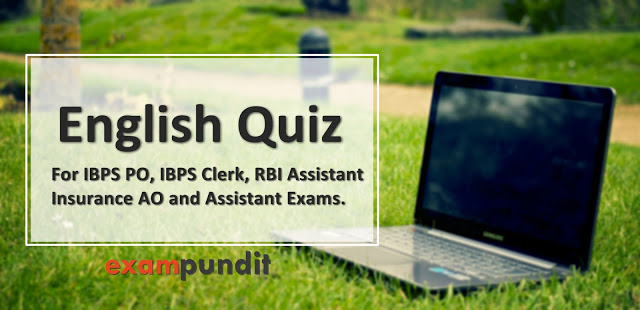Hello and welcome to exampundit. Here is a set of English Quiz for the upcoming Exams in 2017.
Read the passage carefully and answer the questions given below it. Certain
words/ phrases have been given in bold to help you locate them while answering
some of the questions.
peer-to-peer (P2P) lending, in which online platforms connect borrowers to
people with money to lend for a fee that covers services like preliminary
creditworthiness profiling, repayment and recovery facilitation, is welcome.
Light-touch regulation is warranted to enable an orderly growth of the nascent sector. It will help P2P
startups, numbering about 30 now, to increase their customer base, and deliver
credit to small and medium industries and sectors of the economy that do not
have access to formal finance. Some additional competition to banks,
non-banking financial companies (NBFCs), microfinance and traditional
moneylenders is welcome. But it should be regulated: missing regulation in
China led to largest P2P lender Ezubao turning insolvent after it was alleged to have run a Ponzi scheme. RBI
supervision is sensible, even if P2P platforms do not pose any systemic risk.
The only apparent reason why the RBI wants to regulate P2P operators as NBFCs
is expedience: the RBI Act would not need to be amended to recognize a new
category of financial intermediary. But this is not good enough. Unlike and
NBFC, a P2P platform does not take the money that is lent on to its books. It
cannot accept deposits or promise assured returns directly or indirectly. It
merely credibly introduces the lender and the borrower, and facilitates recovery. Credit moves
directly from the lender’s bank account to the borrower’s. Applying norms
similar to those for NBFCs – a minimum capital requirement, limit on leverage
and having personnel with a background in finance – is, therefore, illogical. The
case for prudential limits on the
maximum contribution by the lender to a borrower or segment of activity is,
however, compelling, given the poor level of financial literacy in India. Fit
and proper criteria promoters, directors and CEO are in order, as is a
brick-and-mortar presence in India for the P2P platform. A system of data
sharing with banks and the credit information bureau is desirable, with complementary laws on data protection.
1. Which of the following is not one of the functions of P2P operators?
1) To introduce the lender and the borrower
2) To act not more than just as an intermediary between borrowers and lenders
3) To accept the money lent on its books of accounts
4) To facilitate recovery of outstanding loans
5) None of the above
2. The “light-touch regulation” will help:
A) Those sectors of the economy that do not have access to formal finance.
B) P2P startups increase their customer base
C) Big business houses set up big industries and provide opportunity to youth
1) Only (A)
2) Only (B)
3) Only (C)
4) (A) and (B)
5) (A), (B) and (C)
3. What types of services do P2P operators provide for which they charge a fee? Answer in the context of the passage.
A) Connecting borrowers to money lenders
B) Repayment & recovery facility
C) Preliminary creditworthiness profiling
1) (A) and (B)
2) (B) and (C)
3) (A) and (C)
4) (A), (B) & (C)
5) Only (A)
4. The main purpose of bringing about “light-touch regulation” is to:
1) Provide loans to startups to ensure efficiency of their business
2) Use idle money of big business houses
3) Enable an orderly growth of P2P startups.
4) (1) and (3)
5) (1), (2) & (3)
5. Find the statement which is not based on the facts mentioned in the passage.
1) The regulating of P2P lending business will bring additional competition to banks, NBFCs, microfinance and traditional moneylenders.
2) The only reason why RBI wants to regulate P2P operators as NBFCs is to expedite the functioning of P2P operators.
3) The P2P lending business in China has achieved a great success.
4) For the success of P2P lending business, norms similar to those for NBFCs is not at all necessary.
5) None of the above
Directions (Q. 6-8): Choose the word which is MOST SIMILAR in meaning to the word printed in bold as used in the passage.
6. Nascent
1) Transitory
2) Developing
3) Shrinking
4) Flourished
5) Withering
7. Prudential
1) Expensive
2) Wasteful
3) Uneconomical
4) Extravagant
5) Careful
8. Complementary
1) Independent
2) Completing
3) Uncontrolled
4) Sovereign
5) Unrelated
Directions (Q. 9-10): Choose the word which is MOST OPPOSITE in meaning of the word printed in bold as used in the passage.
9. Alleged
1) Sure
2) Purported
3) Described
4) Averred
5) Suspected
10. Facilitates
1) Expedites
2) Promotes
3) Delays
4) Helps
5) Simplify
Answers:
- 3
- 4
- 4
- 3
- 3
- 2
- 5
- 2
- 1
- 3
(adsbygoogle = window.adsbygoogle || []).push({});
Regards
Team ExamPundit



